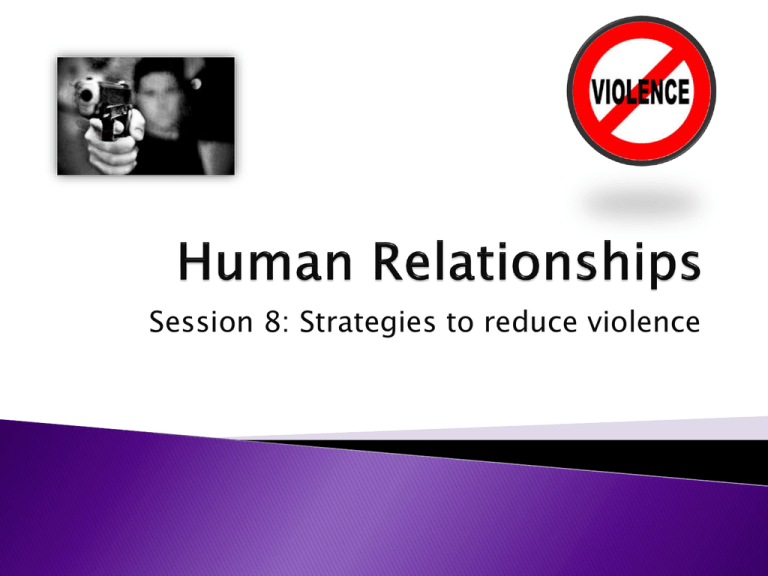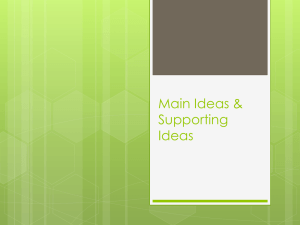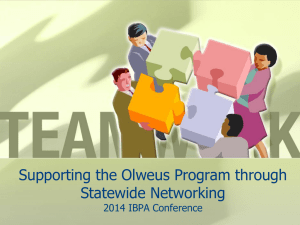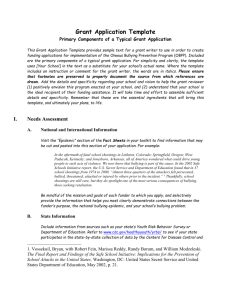File
advertisement

Session 8: Strategies to reduce violence Discuss relative effectiveness of two strategies for reducing violence 1. 2. Olweus Bullying Prevention Programme (OBPP) Metropolitan Area Child Study (MACS) for prevention of aggressive behaviour & violence in children 1. Olweus Bullying Prevention Programme (OBPP) Programme is universal i.e. it includes all staff, parents and students in school The aim is to change the school environment as a whole while targeting individual students Teachers receive training so that they are equipped with the skills to recognise and deal with bullying and implement cooperative learning strategies within the classroom. Also includes supervision of playgrounds and lunchroom Students fill out questionnaires with the aim of identifying bullies in elementary, middle and high school Aims to help both bullies and their victims Adults should be positive role models and set firm limits to unacceptable behaviour Longitudinal study on the effect of OBPP on bullying Study was conducted in Bergen area of Norway after 3 adolescents has committed suicide as a result of bullying Sample of 2500 children from 5th-8th grade participated in OBPP for 2 years Data collection took place through observations and questionnaires for teachers & students Results Showed an overall improvement of 50% reduction in self-reported bullying incidents and a general improvement of social climate in classrooms Students’ self reports showed: ◦ ◦ ◦ ◦ Higher satisfaction with school life Improved order and discipline More positive social relationships More positive attitudes towards school & schoolwork in general Results indicate that OBPP has a higher level of effectiveness Longitudinal study so was able to review effectiveness of programme over period of years Only generalisable to students in 5th-8th grade in Norway Issues with self report data for bullying. Lack of honesty among bullies? Victims reluctant to report bullying? Impact of suicides of bullied teens may have increased awareness of bullying regardless of programme and may be to account for reported improvements Study on implementation of OBPP in US Participants were 13 inner city schools in one urban school district Programme ran for 4 years but only 9 schools completed Results showed that not all schools followed programme as it is intended (only 48% fidelity to programme) Observed bullying incidents decreased 25.5% in all schools On average students’ self reported bullying incidents increased from 39-43% in the 4 years BUT schools that had implemented the programme most rigorously actually had a decrease in self reported bullying incidents Black argued that the mixed results in terms of reduction of bullying could be due to less rigorous implementation, lack of resources and cultural differences between Norway & USA. OBPP was developed in Norway where social responsibility for all is a core value. This value is perhaps difficult to translate into the American culture of individual independence Provides cross cultural data on effectiveness of OBPP Due to large drop out rate and lack of proper implementation in some schools it is unclear whether programme is effective in US, however, schools that followed programme did report decrease in self reported bullying incidents Programme implementation in all schools led to an increase in supervision of students which could possibly account for decrease in bullying rather than the programme itself Research in Norway has suggested that this programme is effective. However, research conducted in the US had mixed results. Unclear whether this programme can be used universally or is more suited to Norwegian culture where shared social responsibility is emphasized 2. Metropolitan Area Child Study (MACS) for prevention of aggressive behaviour & violence in children Programme consists of: ◦ A classroom programme with focus of empathy training and social problem-solving skills ◦ Training in social skills which takes place in small group sessions where students meet and discuss peer relations and adequate social problem-solving strategies ◦ Family counseling which take place in small groups with other families. The meetings start with lessons and then families discuss specific issues in relation to family-specific problems Aim: to investigate whether violence prevention could reduce aggression and violence Procedure: Longitudinal quasi experimental field study 2181 elementary students classified as high risk from 2 inner city areas in Midwest of USA Intervention ran over 8 years Participants mostly belonged to ethnic minority groups and many were poor Procedure: Quasi experimental field study consisted of 4 conditions: 1. 2. 3. 4. Control group- no intervention Full programme Only classroom programme Classroom programme and social skills training programme for high risk children Results Overall there was no effect of the programme on overall levels of aggression but there was an impact in some of the subgroups: Students who had participated in full programme either early or late and came from low risk schools showed less aggression compared to control group Students from high risk schools showed a higher level of aggression after the programme compared to the control group Study showed that early intervention is most effective is fully programme is offered. Reviewed relative effectiveness of MACS Suggest that: ◦ Normally aggressive behaviour has negative consequences in peer groups but it seems that some aggressive children are able to maintain a popular status among peers They found that: ◦ Youth who began the MACS late intervention programme and already had high levels of popularity were able to increase in aggressiveness while in the programme According to Guerra: if aggression is seen as normal (normative) in the peer group (e.g. because you live in a violent neighbourhood) and it pays off (e.g. increased attention from teachers and increased peer status) it is likely to continue in spite of an intervention programme There are problems is precise measurement of effectiveness of programme Most effect studies look at average scores (e.g. how many children become delinquent) but do not include how various factors could affect outcomes for different groups This means that programme may be effective sometimes and with particular groups but may not be effective in other situations Seems that school based strategies to reduce violence are not always very effective It is probably because violence is a complex phenomenon that must be addressed at social, cultural, individual and socioeconomic levels It is necessary to look at what works when and with whom as well as when it does not work (Guerra et al, 2006) Ferguson et al (2007) performed meta analysis of school based anti bullying programmes and found that overall they were not very effective in reducing bullying and violent behaviours within schools The programmes that target at-risk youth were slightly more effective. Lack of effectiveness could be because bullies may use bullying to climb social dominance hierarchy at expense of others and that bullying intervention programmes offer no incentives for bullies







